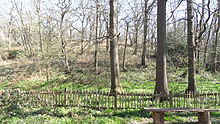Abbey Wood is a 6.3-hectare (16-acre) geological Site of Special Scientific Interest in Abbey Wood in the London Borough of Bexley. It is located in Lesnes Abbey Woods south-east of the ruins of Lesnes Abbey.[1] Members of the public can dig for fossils in a small area designated as the Fossil Bed with the permission of the Lesnes Abbey ranger.
| Site of Special Scientific Interest | |
 | |
| Location | Greater London |
|---|---|
| Grid reference | TQ481786 |
| Interest | Geological |
| Area | 6.3 hectares |
| Notification | 1987 |
| Location map | Magic Map |

The site is late Palaeocene[2] and early Eocene[3][dead link] 50 to 60 million years ago. Important Palaeocene finds in the Blackheath Beds on the site include 22 species of mammals in 12 orders, which resemble the Wasatchian fauna of North America. It has also yielded one of only two Palaeocene birds found in Britain, the holotype of Marinavis longirostris, a large Procellariiform sea bird, and the site may throw light on Procellariiform/Pelecaniform evolution.[2]
Excavations of the site in the twentieth century produced a rich yield of Eocene mammals and many shark teeth. It is particularly important for fish, including 16 type specimens.[3] It has three entries in the Geological Conservation Review database, for Tertiary mammalia,[4][dead link] Mesozoic and Tertiary fish and amphibians,[5][dead link] and aves.[6]
See also
editReferences
edit- ^ "Abbey Wood map". Natural England.
- ^ a b Natural England Citation, Abbey Wood Archived 2012-10-24 at the Wayback Machine
- ^ a b Geological Conservation Review, Volume 16: Fossil Fishes of Great Britain, Chapter 14: British Cenozoic fossil fishes sites, Site: ABBEY WOOD (GCR ID: 2903), 1980-2007
- ^ "Abbey Wood (Tertiary Mammalia)". Joint Nature Conservation Committee. Retrieved 13 January 2016.
- ^ "Abbey Wood (Mesozoic - Tertiary Fish/Amphibia)". Joint Nature Conservation Committee. Retrieved 13 January 2016.
- ^ "Abbey Woods (Aves)". Joint Nature Conservation Committee. Retrieved 13 January 2016.